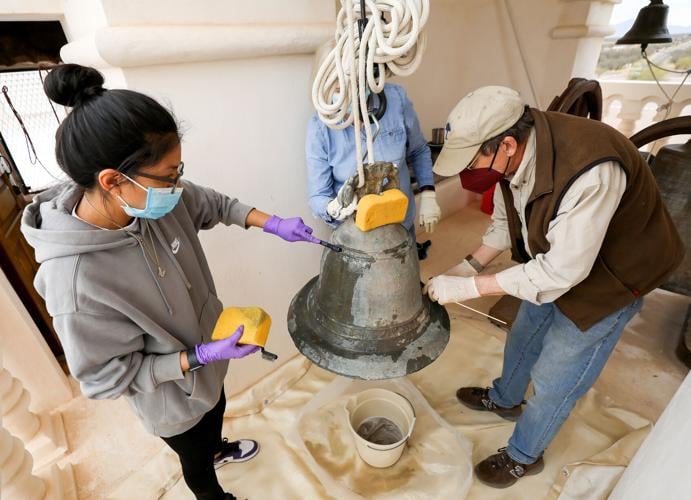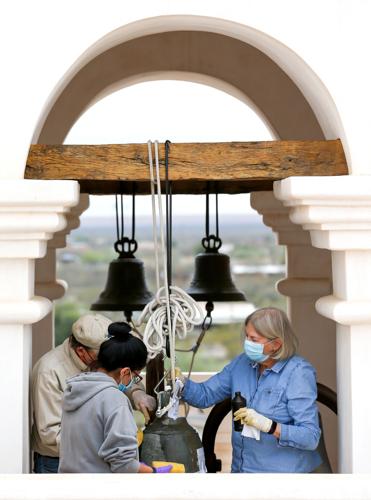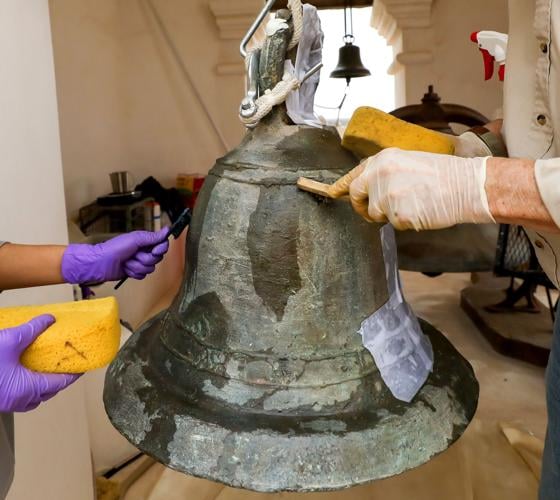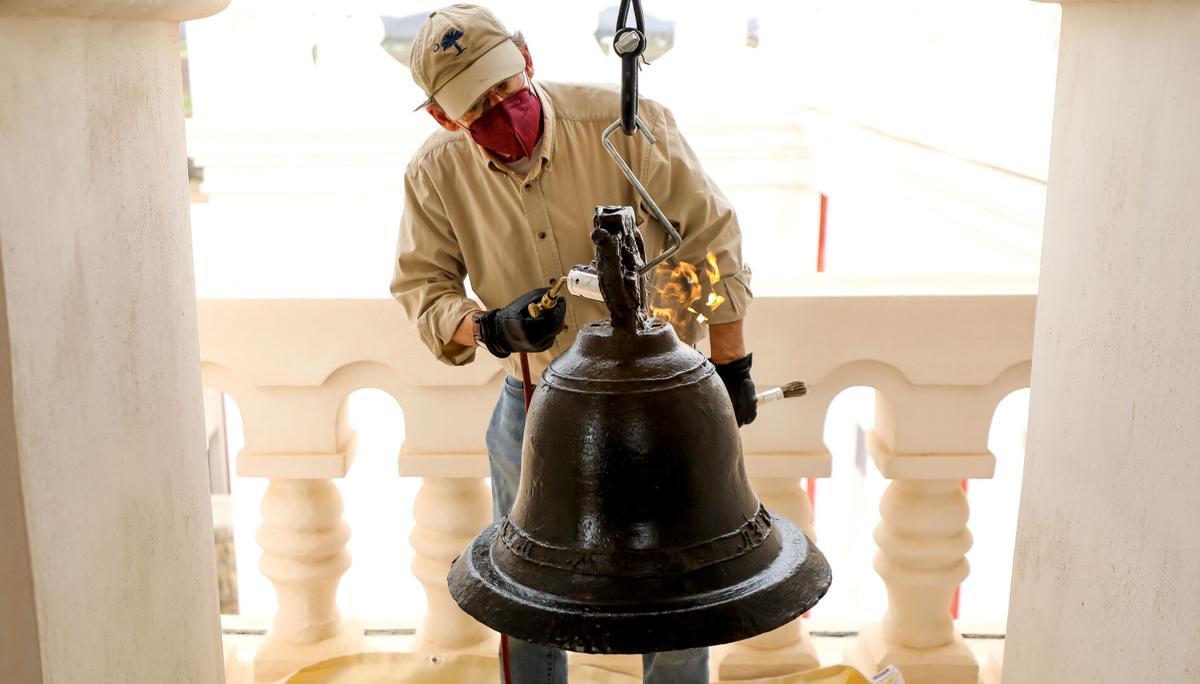For almost as long as San Xavier has been standing, its bells have rung out to announce the passing of people connected to the mission.
In the surrounding Tohono O’odham village of W:ak, the chimes are a solemn sound, one that serves as both a tribute and a news report.
So what was Ron Harvey doing in the church’s belfry on Monday, blasting away at one of the bells with a blowtorch?
He was there to make sure the historic bronze bells of San Xavier del Bac will keep ringing for decades to come.
Harvey is one of eight conservators brought together by Patronato San Xavier, the nonprofit that oversees preservation and fundraising for the late-17th-century church. The multidisciplinary team spent the past two years painstakingly cleaning and restoring the mission’s four oldest bells.
The work wrapped up last week, when the last of the bells was rehung in San Xavier’s west tower.
“Bells are critical to a mission,” said Patronato board member Nancy Odegaard, who led the restoration project. “The instrument has to function.”
Rite as rang
Ivan Burrell has been ringing the bells at San Xavier for the past 20 years or so. He’s one of just five people entrusted with the task.
Anytime there is a death in the community, a bell ringer will climb the stairs to the belfry to mark the passing with a simple code: three sharp rings for a man or two sharp rings for a woman.
The death of an infant is announced with one, tiny tap on a single bell.
“It is really an honor to do that for the families,” said Burrell, who also works as a custodian at the mission.
He recites two small prayers before he pulls the braided rope — one for the grieving loved ones, the other an appeal to the bells themselves.
“We ask the bells to help us do good,” the 41-year-old said. “It’s beautiful when I hear them ring.”
San Xavier Pastor William Minkel said the phone at the church often rings soon after the bells do, as people in the community try to find out who has died.
The bells also sound on special occasions, like the election of a new Pope or the feast days in early October and early December for Saint Francis of Assisi and Saint Francis Xavier. Then it’s all of the bells at once, sometimes for 10 or 15 minutes straight.
“We call them celebration bells,” Burrell said. “The first time I did it, I really couldn’t hear because of the ringing in my ears.”
He bought himself a pair of protective earmuffs after that.
Burrell was selected for the job by longtime San Xavier bell ringer Fred Garcia, who quite literally showed him the ropes.
When Garcia died about 6 years ago, Burrell and his fellow ringers honored the man with the full “celebration bells” during his funeral procession.

Susie Moreno, left, conservative apprentice, and Ron Harvey, conservator and owner of Tuckerbrook Conservation LLC, clean the outside of a historic bronze bell at San Xavier Mission.
Wax and flame
The exact age of San Xavier’s four bronze bells is unknown, but one or more of them may predate the construction of the mission starting in 1783.
“We’re currently studying them to see if we can learn anything more about their history and provenance,” said Starr Herr-Cardillo, Patronato’s conservation project manager. “It’s a part of the site’s history that hasn’t really been examined closely until now.”
Herr-Cardillo said the pressing need to tend to the bells became apparent a few years back, when the clapper broke on one of them, knocking it out of commission.
An 80-pound hunk of bronze might seem indestructible, but the metal does corrode over time and even a single crack can keep a bell from ringing.
“It’s about preserving heritage in arguably the most important building in Arizona,” said Odegaard, who is a retired University of Arizona professor and the former head of the Preservation Division at the Arizona State Museum.
Each of the bells was brushed clean and then scrubbed with a special blend of mild detergent to remove dust and “bird stuff,” Odegaard said.
The clappers were removed and soaked clean, while a heated solution made from Calgon was poured over the bells to help remove rust and calcium deposits.
Then came Harvey with his propane torch.
He used the flame to heat the bells to just beyond the melting point of a special wax that was then brushed across the metal to protect it.
“The wax acts as a sacrificial coating,” blocking the acid from bird droppings and other contaminants from reaching the bronze, Harvey explained.

An hunk of bronze might seem indestructible, but the metal does corrode over time and even a single crack can keep a bell from ringing.
The heating process helps the wax seep into the uneven surface of the bell and coat it completely.
“You’re never getting it hot enough to melt the metal,” said Harvey, who runs a private conservation consulting firm in Maine.
The coating will only last for about three years on its own, he said, but it can be maintained indefinitely with routine applications of a different wax that doesn’t require the blow torch.
The team settled on the wax treatment after trying out a dozen different coatings in the lab using pieces of brass. The process took about two months and involved a special chamber in the Engineering Department at the U of A that can mimic and accelerate the effects of weather, temperature and sunlight.
The bronze bells are still in use, so conservators cleaned and coated them to keep them ringing.
The bells at San Xavier used to hang from old chains that bled rust on them and allowed them to swing and crash into each other. Those chains have been replaced by custom, U-shaped iron hangers, forged in W:ak village by Jerry Enis, that now hold the bells in place.
Wood specialist Luke Addington repaired and sealed the original pinewood beams from which the hangers are mounted.
Herr-Cardillo said they will be sharing all the treatment methods they developed and the techniques they learned with other old missions and historic sites “with similar conservation challenges” in the Southwest and Mexico.
That rings a bell
The conservators made one surprising discovery during their work: Each of the bells has its own name. One is the San Juan Bautista bell, another is the San Pedro, another the San Augustin.
Their names were printed on them in raised Roman letters that could only be read when the bells were cleaned.
“I’ve heard that when they get made, they kind of get baptized,” Odegaard said.

Nancy Odegaard, conservator, right, Susie Moreno, conservative apprentice, and Ron Harvey, conservator and owner of Tuckerbrook Conservation LLC, clean the outside of a historic bronze bell at San Xavier Mission.
The bell they worked on Monday is named for San Xavier. It’s the largest of the four, with several flaws and irregularities that make Odegaard suspect it may have been cast on the church grounds as the mission was built more than two centuries ago.
More is known about the San Augustin bell, because it once hung above the chapel door at the Presidio San Agustin de Tucson.
Research suggests that bell could date back to 1775 or earlier and may have been given to the mission in the late 1800s by Jean-Baptiste Salpointe, the first Catholic bishop of Arizona.
Historic photographs appear to show it hanging above the mortuary chapel at San Xavier in the early 1900s.
Since the San Augustin bell is no longer in use, it was the first to be restored and the only one taken off site to be worked on. It spent most of 2020 in the Arizona State Museum’s Conservation Lab, where it underwent a thorough examination and cleaning.
Over the course of about eight months, conservators documented everything about it, including two small craters that may have been left in the side of it by gun shots. They also took before-and-after sound recordings to make sure the bell wasn’t altered by the protective coating applied to it.
“It’s really important that our treatment doesn’t change the way the bells sound,” Odegaard said.
Conservators used what they learned from that first bell to develop a plan to treat the other three from inside the west tower so the bells would still be available if the church or the village needed them.
The San Pedro bell was cleaned and coated with wax last fall, followed by the San Juan Bautista bell in January. The San Xavier bell was treated and hung back where it belongs on Wednesday, just in the nick of time.
“This morning we had to ring it for the death of a young woman, just 42 years old,” Burrell said on Thursday. “I’m glad they got it back up when they did.”
Photos: San Xavier Mission enters phase two of conservation project
Conservation of Mission San Xavier's East Tower
Updated
Eric Means, bottom right, project general contractor, and Jarvis Juan, crew member, work on building the scaffolding for phase two of the conservation of San Xavier's East Tower project at San Xavier Mission, 1950 W. San Xavier Rd., in Tucson, Ariz. on March 24, 2021.
Conservation of Mission San Xavier's East Tower
Updated
Jarvis Juan, crew member of Means Design and Building, works on building the scaffolding for phase two of the conservation of San Xavier's East Tower project at San Xavier Mission, 1950 W. San Xavier Rd., in Tucson, Ariz. on March 24, 2021.
Conservation of Mission San Xavier's East Tower
Updated
Eric Means, project general contractor, and Jarvis Juan, crew member, work on building the scaffolding for phase two of the conservation of San Xavier's East Tower project at San Xavier Mission, 1950 W. San Xavier Rd., in Tucson, Ariz. on March 24, 2021.
Conservation of Mission San Xavier's East Tower
Updated
The scaffolding for phase two of the conservation of San Xavier's East Tower project is photographed at San Xavier Mission, 1950 W. San Xavier Rd., in Tucson, Ariz. on March 24, 2021.
Conservation of Mission San Xavier's East Tower
Updated
Visitors walk outside of the San Xavier Mission while Eric Means, project general contractor, and Jarvis Juan, crew member, work on building the scaffolding for phase two of the conservation of San Xavier's East Tower project at San Xavier Mission, 1950 W. San Xavier Rd., in Tucson, Ariz. on March 24, 2021.
Conservation of Mission San Xavier's East Tower
Updated
A poster informing visitors about the project hangs in front of some fencing while Eric Means, project general contractor, and Jarvis Juan, crew member, work on building the scaffolding for phase two of the conservation of San Xavier's East Tower project at San Xavier Mission, 1950 W. San Xavier Rd., in Tucson, Ariz. on March 24, 2021.
Conservation of Mission San Xavier's East Tower
Updated
Jarvis Juan, crew member of Means Design and Building, works on building the scaffolding for phase two of the conservation of San Xavier's East Tower project at San Xavier Mission, 1950 W. San Xavier Rd., in Tucson, Ariz. on March 24, 2021.
Conservation of Mission San Xavier's East Tower
Updated
Eric Means, project general contractor, and Jarvis Juan (not pictured), crew member, work on building the scaffolding for phase two of the conservation of San Xavier's East Tower project at San Xavier Mission, 1950 W. San Xavier Rd., in Tucson, Ariz. on March 24, 2021.
Conservation of Mission San Xavier's East Tower
Updated
Jarvis Juan, crew member of Means Design and Building, works on building the scaffolding for phase two of the conservation of San Xavier's East Tower project at San Xavier Mission, 1950 W. San Xavier Rd., in Tucson, Ariz. on March 24, 2021.
Conservation of Mission San Xavier's East Tower
Updated
Eric Means, project general contractor, watches as Jarvis Juan (not pictured), crew member, works on building the scaffolding for phase two of the conservation of San Xavier's East Tower project at San Xavier Mission, 1950 W. San Xavier Rd., in Tucson, Ariz. on March 24, 2021.








